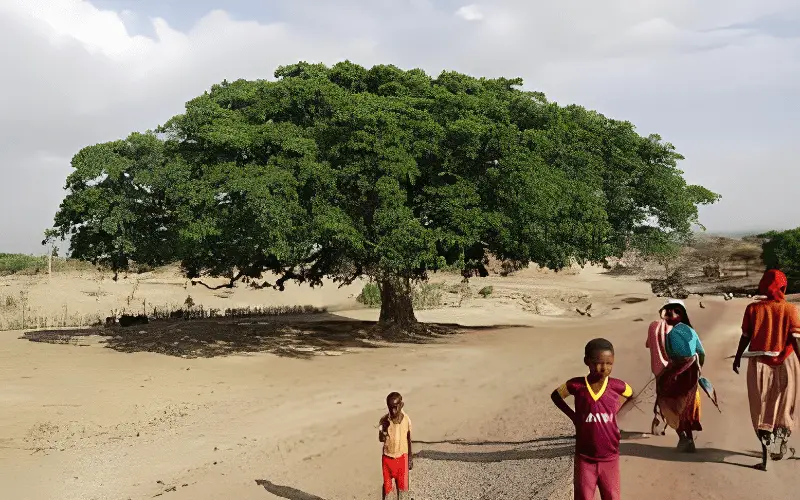Oromo People Roots
Oromo People : History Amidst Contested Narratives
Table of Contents
The Oromo People are one of the Cushitic-speaking groups of people with variations in color and physical characteristics ranging from Hamitic to Nilotic. A brief look at the early history of some of the peoples who occupied north-eastern Africa sheds some light on the ethnic origin of Oromo. The Cushitic speakers have inhabited north-eastern and eastern Africa for as long as recorded history. The land of Cush, Nubia or the ancient Ethiopia in middle and lower Nile is the home of the Cushitic speakers. It was most probably from there that they subsequently dispersed and became differentiated into separate linguistic and cultural groups.
The various Cushitic nations inhabiting north-east and east Africa today are the result of this dispersion and differentiation. The Oromo People form one of those groups which spread southwards, and then east and west occupying large part of the Horn of Africa. Their physical features, culture, language and other evidences unequivocally point to the fact that they are indigenous to this part of Africa.
Available information clearly indicates that the Oromo People existed as a community of people for thousands of years in East Africa (Prouty at al, 1981). Bates (1979) contends, “The Gallas (Oromo) were a very ancient race, the indigenous stock, perhaps, on which most other peoples in this part of eastern Africa have been grafted.”
In spite of the fact that there are several indications and evidences that Oromo are indigenous to this part of Africa, Abyssinian rulers, court historians and monks contend that Oromo are newcomers to the region and did not belong here.
For instance, the Abyssinian court historian, Alaqa Taye (1955), alleged that in the fourteenth and sixteenth centuries the Oromo migrated from Asia and Madagascar, entered Africa via Mombasa and spread north and eastwards. Others have advocated that during the same period the Oromo crossed the Red Sea via Bab el Mandab and spread westwards.
Abyssinian clergies even contended that Oromo People emerged from water. On this issue, based on the points made in The Oromo’s Voice Against Tyranny, Baxter (1985) remarked, “… the contention that the first Oromo had actually emerged from water and therefore, had not evolved to the same level of humanity as the Amhara (i.e. treating a myth of origin as a historical fact); or, more seriously, that Oromo were latecomers to Ethiopia and hence, by implication, intruders and not so entitled to be there as the Amhara.”

Oromo People : Debunking Myth and Bias
Oromo Man The history of the arrival of the Oromo people in the sixteenth century in East Africa from outside is a fabrication and denial of historical facts. It is a myth created by Abyssinian court historians and monks, sustained by their European supporters and which the Ethiopian rulers used to lay claim on Oromo territory and justify their colonization of the Oromo people. Several authorities have indicated that the Oromo were in fact in the North-eastern part of the continent even before the arrival of the Habasha.
According to Perham (1948): “the emigrant Semites landed in a continent of which the North-East appears to have been inhabited by the eastern groups of Hamites, often called Kushites, who also include the Gallas.” Paulitschke (1889) indicated that Oromo were in East Africa during the Aksumite period. As recorded by Greenfield (1965), Oromo reject the view that they were late arrivals, “… old men amongst the Azebu and Rayya Galla dismiss talk of their being comparative newcomers.”
Their own (Abyssinians) oral history and legends attest to the fact that Oromo People have been living in Rayya for a long time. Beke (cited by Pankurst, 1985-86) quoted the following Lasta legend: “Menilek, the son of Solomon, … entered Abyssinia from the East, beyond the country of the Rayya or Azebo Gallas.” There are also evidence (Greenfield et al, 1980) that at least by the ninth and tenth centuries that there were Oromo communities around Shawa and by about the fourteenth century settlements were reported around Lake Tana.
The recent discovery, (Lynch and Robbins, 1978), in northern Kenya of the pillars that Oromo used in the invention of their calendar system, dated around 300 B.C., is another indication that Oromo have a long history of presence as a community of people, in this part of Africa.
The so called “Galla invasion of Ethiopia” is also a tale. It was first written around 1590 by a monk called Bahrey and henceforth European historians and others almost invariably accepted this story as a fact. From his writing, it is evident that he was biased against Oromo.
The following quotation from Bahrey, (in Beckingham et al, 1954), vividly illustrates typical Abyssinian cultural, religious and racial biases against Oromo. He began his book “The History of the Galla”: “I have begun to write the history of the Galla in order to make known the number of their tribes, their readiness to kill people, and the brutality of their manners.
If anyone should say of my subject, ‘Why has he written a history of a bad people, just as one would write a history of good people?’, I would answer by saying ‘Search in the books, and you will find that the history of Mohamed and the Moslem kings has been written, and they are our enemies in religion.” In fact, it appears that the main purpose of his writing was to encourage Abyssinians against Oromo.

Bahrey, Atseme, Harris, Haberiand and others description of what they called the ‘Galla invasion of Ethiopia’ as an avalanche, a sudden overwhelming human wave which could be likened to a flood or swarms of migratory locust is unrealistic and difficult to imagine to say the least.
The Oromo People Voice Against Tyranny argued that: “… the so-called Galla invasion of the sixteenth century was neither an invasion nor a migration. It was rather a national movement of the Oromo people … with the specific goal of liberating themselves and their territories from colonial occupation. It was nothing more or less than a war of national liberation.” In fact, the last 2000 years were occupied with a gradual expansion of Abyssinians from north to south. This expansion had been checked throughout by Oromo. It was only with the arrival of Europeans and their firearms that Abyssinians succeeded in their southward expansion mainly in the middle of last century.
Oromo People Woman Abyssinian and European historians alleged that there was a sudden population explosion in the Oromo community in the sixteenth century that enabled it to invade Ethiopia. The claim lacks a scientific base. During that time no significant, if at all any, technological development such as discoveries or introductions of medicines, new and improved tools for food production, etc. took place in the Oromo community that could have been the cause for the sudden population explosion. The Oromo community had no advantages of these sort over neighboring communities.
Different areas have been indicated as place where the Oromo People developed or differentiated into its own unique community of people or ethnic group (Braukamper, 1980). According to some ethnologists and historians, the Oromo country of origin was the south-eastern part of Oromia, in the fertile valley of Madda Walaabu in the present Baale region. This conclusion was reached mainly on the basis of Oromo oral tradition.
Based on scanty anthropological evidence, others have also pointed to the coastal area of the Horn of Africa, particularly the eastern part of the Somali peninsula, as the most probable place of Oromo origin. Bruce, an English traveler, indicated that Sennar in Sudan was the Oromo country of origin and that they expanded from there. It should be noted here that many European travelers have suggested the origin of peoples, including Oromo, to be where they met some for the first time, which in most cases happened to be peripheral areas.
There are several groups of Oromo People in East Africa very closely related to the Oromo. For instance, the Somalis are very similar in appearance and culture. The fact that the Somali and Oromo languages share between 30 percent and 40 percent of their vocabulary could be an indication that these two groups of people became differentiated very recently. Other Cushitic-speaking groups living in the same neighborhood that are closely related to the Oromo are Konso, Afar, Sidama, Kambata, Darassa, Agaw, Saho, Baja and other groups.
The Oromo People are also known by another name, Galla. The people neither call themselves or like to be called by this name. They always called themselves Oromoo or Oromoota (plural). It is not known for certain when the name Galla was given to them.
It has been said that it was given to them by neighboring peoples, particularly Amhara, and various origins of the word have been suggested. Some say it originated from the Oromo word ‘galaana’ meaning river in Oromiffa.
Others indicate that it came from an Arabic word ‘qaala laa’. There are other similar suggestions as to the origin of the word. The Abyssinians attach a derogatory connotation to the Galla, namely ‘pagan, savage, uncivilized, uncultured, enemy, slave or inherently inferior’. The term seems to be aimed at generating an inferiority complex in the Oromo.
Oromo People have several clans (gosa, qomoo). The Oromo are said to be of two major groups or moieties descended from the two ‘houses’ (wives) of the person Oromo represented by Borana and Barentu (Barenttuma). Borana was senior (angafa) and Barentu junior (qutisu).
Such a dichotomy is quite common in Oromo society and serves some aspects of their political and social life. The descendants of Borana and Barentu form the major Oromo clans and sub-clans.
They include Borana, Macha, Tuullama, Wallo, Garrii, Gurraa, Arsi, Karrayyu, ltu, Ala, Qalloo, Anniyya, Tummugga or Marawa, Orma, Akkichuu, Liban, Jile, Gofa, Sidamo, Sooddo, Galaan, Gujii and many others. However, in reality there is extensive overlap in the area they occupy and their community groups. And since marriage among Oromo occurs only between different clans there was high degree of homogeneity.
The Oromo People make up ~50% of the population of the Ethiopian Empire. They are found in all the regions of the Ethiopian Empire except for Gondar. They make up a large proportion of the population of llubbabor, Arsi, Baale, Shawa, Hararge, Wallo, Wallagga, Sidamo and Kafa. They are also found in neighboring countries such as Kenya and Somalia. Out of the 50 nations of Africa, only four have larger population than Oromia.





Very interesting information!Perfect just what I was looking for!Leadership